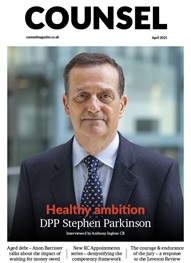*/

Ensuring recruitment processes are fair, and free from bias, is essential to drive diversity at the Bar. Bindi Dholakia and Rachel Krys examine the theory and practice
There has been a push to improve diversity at the Bar for the last 20 years and this has led to a marked change in the diversity of the profession.
The proportion of women at the Bar has almost doubled since 1990, from 21.6% to 38.1% in 2020. Roughly equal numbers of men and women have taken pupillage for more than 20 years.
The proportion of pupils from ethnic minority backgrounds increased by 5% between the 1990/91-1994/95 period and the 2015/16-2019/20 period (from 13.8% to 18.8% on average), but with varying trends for different ethnic groups. For example, the proportion of pupils from Asian/Asian British backgrounds has grown from 6.3% to 9.5%. But the proportion of pupils from Black/Black British backgrounds has remained the same (3.8%) for nearly 30 years (source: Bar Standards Board).
Ensuring recruitment processes are fair, and free from bias is essential in the drive to increase diversity at the Bar.
Anyone embarking on a recruitment process should remind themselves of the key principles of fair selection:
Every part of the process needs to be considered including how it can be designed to make it as fair as possible, ensuring the process attracts and considers candidates which meet the relevant criteria and whether it enables those candidates to succeed on their merits. All of this may sound obvious, but too often processes result in the recruitment of candidates who ‘fit the mould’ or are very good at interviews, rather than the most qualified or appropriate person for the role.
Start with the recruitment panel. It’s important to make the panel as diverse as possible. That means including a mix of men and women, diverse ethnicities, sexualities and disabled people if at all possible. Also think about ensuring the panel includes other diversity – people with different levels of experience, backgrounds and perspectives will all provide a different perspective. A diverse panel helps guard against group think, demonstrates to candidates that diversity is taken seriously and increases the chances of bias being spotted and removed.
Once the panel is in place, move on to the role and how you’ll identify a successful candidate. Focus on the selection criteria and the key qualities, knowledge and experience needed to excel in the role. Resist the temptation to simply recycle the person specification and job description you’ve used before – take the opportunity to think about what you are (or should be) looking for in a future colleague.
Next, think about how you’re going to assess the criteria. For example, if intellectual ability is a key criteria, A-level and degree results might be relevant. However, setting high minimum criteria may disadvantage those who haven’t benefitted from an elite education, or who were grappling with other challenges while studying. Recruiters should bear in mind that academic results are only a proxy for intellectual ability.
Because it’s so hard to measure aptitude within the limited time and information available to recruiters, some chambers include an assessed mini-pupillage in their process. This can be a great way of getting to know candidates better, giving them the opportunity to show you what they’re made of, and find out if they want to work with you. But remember, all the fair recruitment rules still apply – and look out for confirmation or affinity bias when assessing mini pupils.
Many chambers use a combination of assessment methods. But even though interviews are less reliable and more prone to bias than other ‘job simulation’ type of assessment methods, most chambers still use them as part of the selection process. There are ways to make interviews more valid and reliable:
Any part of the selection process can be prone to bias. Be mindful of the following biases that can occur unconsciously:
The best way to avoid bias is to be conscious that we are all biased, take consistent notes, take breaks to prevent tiredness, avoid evaluating the candidate until after the interview and base your evaluation/ratings of the candidate on evidence against the criteria.
Work samples are simply ‘job simulation’ exercises and include written exercises or advocacy exercises that replicate the actual role. Designed well, these can be highly reliable, valid and objective measures of assessing candidates.
Using a combination of both the interview and work sample(s) is recommended.
Whether you’re recruiting new staff, pupils or lateral hires, be mindful of the fair recruitment rules and ensure everyone involved in the process, from the first sift to the final decision, has completed their fair recruitment training and is committed to ensuring a fair and inclusive approach.
Trends in retention and demographics at the Bar: 1990-2020, Bar Standards Board, July 2021,
The Bar Council’s Fair Recruitment Guide details the principles of fair recruitment, designing a fair process and shortlisting, interviewing and selection. It also has templates and work sample ideas. See: bit.ly/3vtWSF8
The Bar Council offers fair recruitment and recruitment refresher training for barristers and chambers. See: bit.ly/427mX9n
The Bar Council Equality and Diversity team provides bespoke support and advice on recruitment processes and monitoring outcomes. Contact equality@barcouncil.org.uk for more information.

There has been a push to improve diversity at the Bar for the last 20 years and this has led to a marked change in the diversity of the profession.
The proportion of women at the Bar has almost doubled since 1990, from 21.6% to 38.1% in 2020. Roughly equal numbers of men and women have taken pupillage for more than 20 years.
The proportion of pupils from ethnic minority backgrounds increased by 5% between the 1990/91-1994/95 period and the 2015/16-2019/20 period (from 13.8% to 18.8% on average), but with varying trends for different ethnic groups. For example, the proportion of pupils from Asian/Asian British backgrounds has grown from 6.3% to 9.5%. But the proportion of pupils from Black/Black British backgrounds has remained the same (3.8%) for nearly 30 years (source: Bar Standards Board).
Ensuring recruitment processes are fair, and free from bias is essential in the drive to increase diversity at the Bar.
Anyone embarking on a recruitment process should remind themselves of the key principles of fair selection:
Every part of the process needs to be considered including how it can be designed to make it as fair as possible, ensuring the process attracts and considers candidates which meet the relevant criteria and whether it enables those candidates to succeed on their merits. All of this may sound obvious, but too often processes result in the recruitment of candidates who ‘fit the mould’ or are very good at interviews, rather than the most qualified or appropriate person for the role.
Start with the recruitment panel. It’s important to make the panel as diverse as possible. That means including a mix of men and women, diverse ethnicities, sexualities and disabled people if at all possible. Also think about ensuring the panel includes other diversity – people with different levels of experience, backgrounds and perspectives will all provide a different perspective. A diverse panel helps guard against group think, demonstrates to candidates that diversity is taken seriously and increases the chances of bias being spotted and removed.
Once the panel is in place, move on to the role and how you’ll identify a successful candidate. Focus on the selection criteria and the key qualities, knowledge and experience needed to excel in the role. Resist the temptation to simply recycle the person specification and job description you’ve used before – take the opportunity to think about what you are (or should be) looking for in a future colleague.
Next, think about how you’re going to assess the criteria. For example, if intellectual ability is a key criteria, A-level and degree results might be relevant. However, setting high minimum criteria may disadvantage those who haven’t benefitted from an elite education, or who were grappling with other challenges while studying. Recruiters should bear in mind that academic results are only a proxy for intellectual ability.
Because it’s so hard to measure aptitude within the limited time and information available to recruiters, some chambers include an assessed mini-pupillage in their process. This can be a great way of getting to know candidates better, giving them the opportunity to show you what they’re made of, and find out if they want to work with you. But remember, all the fair recruitment rules still apply – and look out for confirmation or affinity bias when assessing mini pupils.
Many chambers use a combination of assessment methods. But even though interviews are less reliable and more prone to bias than other ‘job simulation’ type of assessment methods, most chambers still use them as part of the selection process. There are ways to make interviews more valid and reliable:
Any part of the selection process can be prone to bias. Be mindful of the following biases that can occur unconsciously:
The best way to avoid bias is to be conscious that we are all biased, take consistent notes, take breaks to prevent tiredness, avoid evaluating the candidate until after the interview and base your evaluation/ratings of the candidate on evidence against the criteria.
Work samples are simply ‘job simulation’ exercises and include written exercises or advocacy exercises that replicate the actual role. Designed well, these can be highly reliable, valid and objective measures of assessing candidates.
Using a combination of both the interview and work sample(s) is recommended.
Whether you’re recruiting new staff, pupils or lateral hires, be mindful of the fair recruitment rules and ensure everyone involved in the process, from the first sift to the final decision, has completed their fair recruitment training and is committed to ensuring a fair and inclusive approach.
Trends in retention and demographics at the Bar: 1990-2020, Bar Standards Board, July 2021,
The Bar Council’s Fair Recruitment Guide details the principles of fair recruitment, designing a fair process and shortlisting, interviewing and selection. It also has templates and work sample ideas. See: bit.ly/3vtWSF8
The Bar Council offers fair recruitment and recruitment refresher training for barristers and chambers. See: bit.ly/427mX9n
The Bar Council Equality and Diversity team provides bespoke support and advice on recruitment processes and monitoring outcomes. Contact equality@barcouncil.org.uk for more information.
Ensuring recruitment processes are fair, and free from bias, is essential to drive diversity at the Bar. Bindi Dholakia and Rachel Krys examine the theory and practice


Now is the time to tackle inappropriate behaviour at the Bar as well as extend our reach and collaboration with organisations and individuals at home and abroad
A comparison – Dan Monaghan, Head of DWF Chambers, invites two viewpoints
And if not, why not? asks Louise Crush of Westgate Wealth Management
Marie Law, Head of Toxicology at AlphaBiolabs, discusses the many benefits of oral fluid drug testing for child welfare and protection matters
To mark International Women’s Day, Louise Crush of Westgate Wealth Management looks at how financial planning can help bridge the gap
Casey Randall of AlphaBiolabs answers some of the most common questions regarding relationship DNA testing for court
Maria Scotland and Niamh Wilkie report from the Bar Council’s 2024 visit to the United Arab Emirates exploring practice development opportunities for the England and Wales family Bar
Marking Neurodiversity Week 2025, an anonymous barrister shares the revelations and emotions from a mid-career diagnosis with a view to encouraging others to find out more
David Wurtzel analyses the outcome of the 2024 silk competition and how it compares with previous years, revealing some striking trends and home truths for the profession
Save for some high-flyers and those who can become commercial arbitrators, it is generally a question of all or nothing but that does not mean moving from hero to zero, says Andrew Hillier